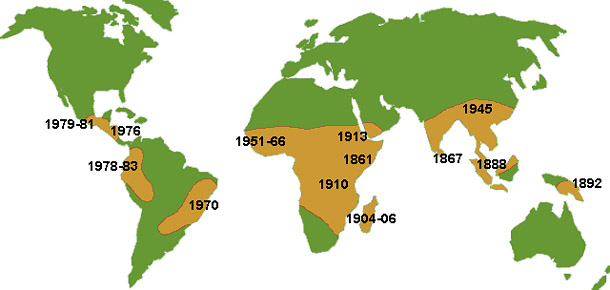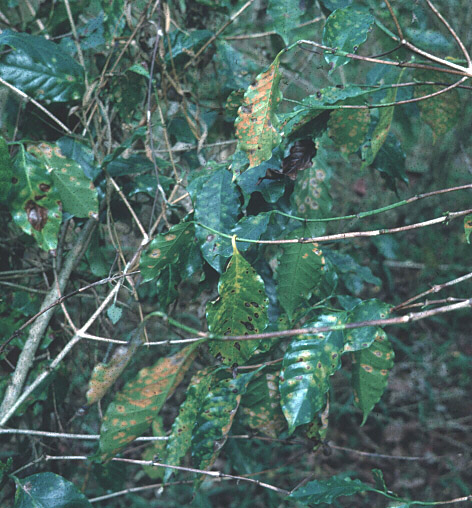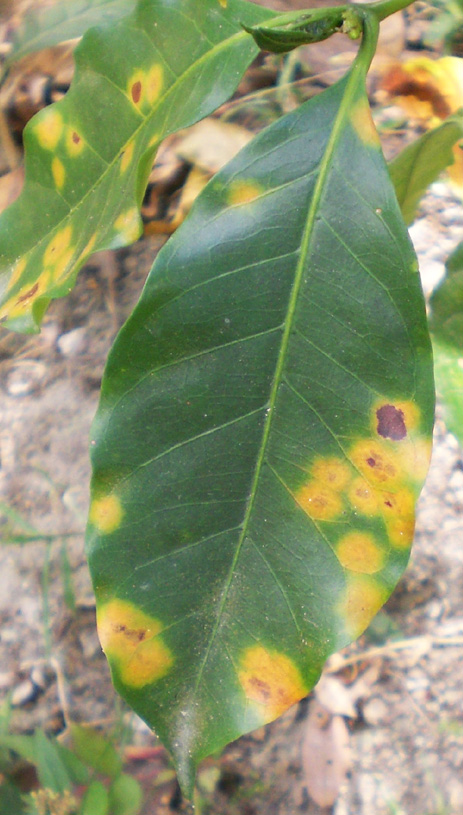Team:Colombia/Project/Problem
From 2012.igem.org
(→Coffee rust (Hemileia vastatrix)) |
(→Coffee rust (Hemileia vastatrix)) |
||
| Line 13: | Line 13: | ||
The fungus responsible of the “coffee leaf disease” ''Hemileia vastatrix'' belongs to the class Basidiomycetes, the order Uredinales, and family Pucciniaceae. Even though it is capable of producing urediniospores and basidiospores, only the former infect the coffee plant while the latter have no known susceptible host. Urediniospores infect usually during rainy seasons, since germination requires a 24 to 48 hour continuous presence of free water (rain or heavy dew). Infection occurs over a wide range of temperature: from 15°C to 28°C with an optimum of 22°C, and only occurs through stomata on the underside of the leaf, so it does not form the pustules typical of many rusts. The infected leaves drop prematurely, which reduces photosynthetic capacity and weakens the plant (as seen in the following pictures), altogether reducing next season’s berry yield (as much as 10-fold) (Arneson, 2000). | The fungus responsible of the “coffee leaf disease” ''Hemileia vastatrix'' belongs to the class Basidiomycetes, the order Uredinales, and family Pucciniaceae. Even though it is capable of producing urediniospores and basidiospores, only the former infect the coffee plant while the latter have no known susceptible host. Urediniospores infect usually during rainy seasons, since germination requires a 24 to 48 hour continuous presence of free water (rain or heavy dew). Infection occurs over a wide range of temperature: from 15°C to 28°C with an optimum of 22°C, and only occurs through stomata on the underside of the leaf, so it does not form the pustules typical of many rusts. The infected leaves drop prematurely, which reduces photosynthetic capacity and weakens the plant (as seen in the following pictures), altogether reducing next season’s berry yield (as much as 10-fold) (Arneson, 2000). | ||
| - | [[File:CR03.jpg|frame| | + | [[File:CR03.jpg|frame|left|Figure 2. The infected leaves drop prematurely, leaving long expanses of twig devoid of leaves]] |
| - | [[File:CR02.jpg|thumb| | + | [[File:CR02.jpg|thumb|right|400px|Figure 3. Coffee rust lesions often concentrate on the margins and tips of leaves. (Photo by P.A. Arneson).]] |
==Bacterial Wilt (''Ralstonia solanacearum'')== | ==Bacterial Wilt (''Ralstonia solanacearum'')== | ||
Revision as of 18:39, 14 July 2012
Template:Https://2012.igem.org/User:Tabima
Contents |
The Problem
Coffee rust (Hemileia vastatrix)
Coffee rust is the most economically important coffee disease in the world, and in monetary value, coffee is the most important agricultural product in international trade. Even a small reduction in coffee yields or a modest increase in production costs caused by the rust has a huge impact on the coffee producers, the support services, and even the banking systems in those countries whose economies are absolutely dependent on coffee export (Arneson, 2000).
The fungus responsible of the “coffee leaf disease” Hemileia vastatrix belongs to the class Basidiomycetes, the order Uredinales, and family Pucciniaceae. Even though it is capable of producing urediniospores and basidiospores, only the former infect the coffee plant while the latter have no known susceptible host. Urediniospores infect usually during rainy seasons, since germination requires a 24 to 48 hour continuous presence of free water (rain or heavy dew). Infection occurs over a wide range of temperature: from 15°C to 28°C with an optimum of 22°C, and only occurs through stomata on the underside of the leaf, so it does not form the pustules typical of many rusts. The infected leaves drop prematurely, which reduces photosynthetic capacity and weakens the plant (as seen in the following pictures), altogether reducing next season’s berry yield (as much as 10-fold) (Arneson, 2000).
Bacterial Wilt (Ralstonia solanacearum)
References
Arneson, P. A. (2000). Coffee rust. The Plant Health Instructor. doi:10.1094/PHI-I-2000-0718-02
 "
"


